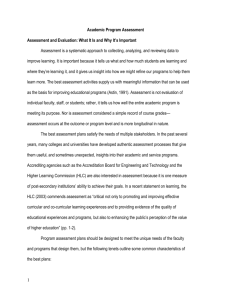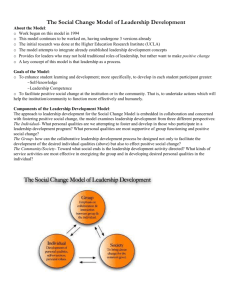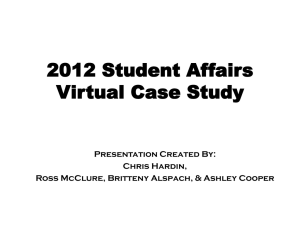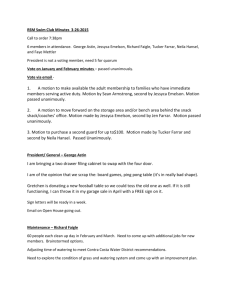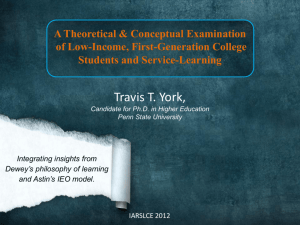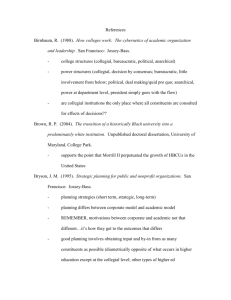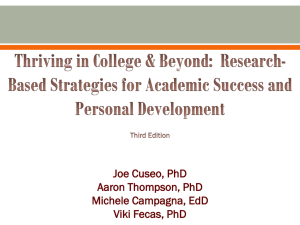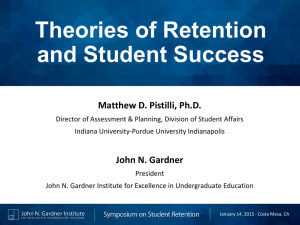How Service Learning Affects Students Executive Summary Alexander W. Astin
advertisement
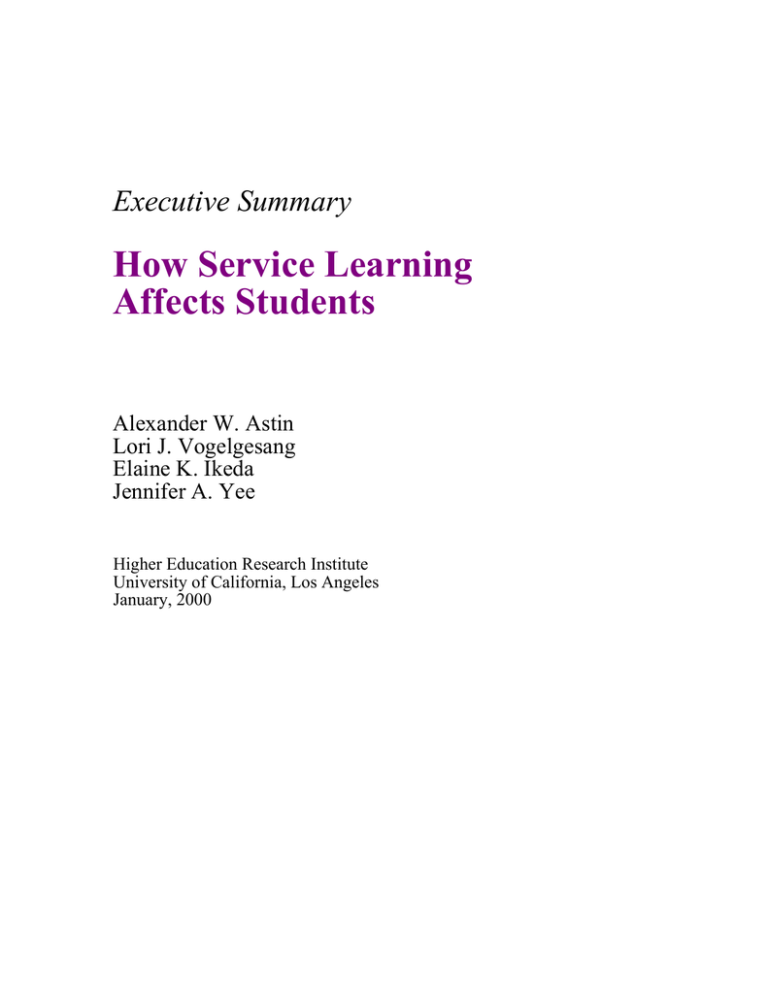
Executive Summary How Service Learning Affects Students Alexander W. Astin Lori J. Vogelgesang Elaine K. Ikeda Jennifer A. Yee Higher Education Research Institute University of California, Los Angeles January, 2000 Purpose The two major goals of this study were: 1) to explore the comparative effects of service learning and community service on the cognitive and affective development of college undergraduates and 2) to enhance our understanding of how learning is enhanced by service. These questions were explored by means of a quantitative longitudinal study of a national sample of students at diverse colleges and universities and a qualitative study of students and faculty who participated in service learning at a subset of these institutions. Method Longitudinal data were collected from 22,236 college undergraduates attending a national sample of baccalaureate-granting colleges and universities. These students were followed up during the fall of 1998; most of them had entered college as freshmen in the fall of 1994. Thirty percent of the students participated in course-based community service (service learning) during college, and an additional 46 percent participated in some other form of community service. The remaining 24 percent did not participate in any community service during college. The impact of service learning and community service was assessed on 11 different dependent measures: academic outcomes (three measures), values (two measures), self-efficacy, leadership (three measures), career plans, and plans to participate in further service after college. Most of these outcomes were pretested when the students entered college as freshmen. Four additional outcome measures were examined for a subsample of students for whom standardized test scores (GRE-Verbal, GRE-Quantitative, LSAT, MCAT) were available. Only students for whom freshmen SAT or ACT scores were available were used in these analyses (sample sizes ranged from 358 for the MCAT to 1,028 for the GRE). Multivariate controls were used for both freshmen characteristics and institutional characteristics (size, type, selectivity, etc.) before the comparative impact of service learning and community service was assessed on the eleven student outcomes. The qualitative portion of the study involved in-depth case studies of service learning on three different campuses. Individual and group interviews with faculty and students, together with classroom observations, were conducted at each site. Principal Findings • Service participation shows significant positive effects on all 11 outcome measures: academic performance (GPA, writing skills, critical thinking skills), values (commitment to activism and to promoting racial understanding), selfefficacy, leadership (leadership activities, self-rated leadership ability, interpersonal skills), choice of a service career, and plans to participate in service after college. These findings directly replicate a number of recent studies using different samples and methodologies. • Performing service as part of a course (service learning) adds significantly to the benefits associated with community service for all outcomes except interpersonal skills, self-efficacy and leadership. Positive results for the latter two outcomes were borderline (i.e., p < .05). • Benefits associated with course-based service were strongest for the academic outcomes, especially writing skills. • Results with graduate and professional school admissions tests were generally non-significant, with one exception: service participation can have a positive effect on the student’s LSAT score, but only if the student is able to discuss the service experience with the professor. • Service participation appears to have its strongest effect on the student’s decision to pursue a career in a service field. This effect occurs regardless of whether the student’s freshmen career choice is in a service field, a non-service field, or “undecided.” • The positive effects of service can be explained in part by the fact that participation in service increases the likelihood that students will discuss their experiences with each other and that students will receive emotional support from faculty. • Both the quantitative and qualitative results suggest that providing students with an opportunity to process the service experience with each other is a powerful component of both community service and service learning. Compared to community service, taking a service-learning course is much more likely to generate such student-to-student discussions. • Better than four service-learning students in five felt that their service “made a difference” and that they were learning from their service experience. • The single most important factor associated with a positive service-learning experience appears to be the student’s degree of interest in the subject matter. Subject-matter interest is an especially important determinant of the extent to which (a) the service experience enhances understanding of the “academic” course material, and (b) the service is viewed as a learning experience. These findings provide strong support for the notion that service learning should be included in the student’s major field. • The second most significant factor in a positive service-learning experience is whether the professor encourages class discussion. • The frequency with which professors connect the service experience to the course subject matter is an especially important determinant of whether the academic material enhances the service experience, and whether the service experience facilitates understanding of the academic material. • The extent to which the service experience is enhanced by the academic course material depends in part upon the amount of training that the student receives prior to service participation. • Qualitative findings suggest that service learning is effective in part because it facilitates four types of outcomes: an increased sense of personal efficacy, an increased awareness of the world, an increased awareness of one’s personal values, and increased engagement in the classroom experience. • The qualitative findings suggest that both faculty and students develop a heightened sense of civic responsibility and personal effectiveness through participation in service-learning courses. • Both qualitative and quantitative results underscore, once again, the power of reflection as a means of connecting the service experience to the academic course material. The primary forms of reflection used were discussions among students, discussions with professors, and written reflection in the form of journals and papers. • Both the qualitative and quantitative findings provide strong support for the notion that service-learning courses should be specifically designed to assist students in making connections between the service experience and the academic material. Acknowledgements We would like to thank the many individuals who have helped in various phases of this project. Scott Myers-Lipton and Per Larssen provided valuable assistance to us in the data collection phase of this project. Our colleagues Robert Emerson, Kris Gutierrez, Edward Zlotkowski, Helen Astin and Linda Sax provided us with helpful feedback at various stages of this project. And special thanks to Bill Korn for managing the complex data processing tasks needed throughout this project. We would also like to thank the faculty members, academic administrators and institutional researchers who assisted us in coordinating the dissemination of the surveys on each of the participating campuses. Special thanks to Richard Couto and Elizabeth MacNabb at the University of Richmond, Regan Schaeffer at Pepperdine University, and Parvin Kassaie at the University of California, Los Angeles for their assistance in coordinating the faculty and student interviews on their respective campuses. We also want to acknowledge the help of Jerry Berberet, who assisted us in engaging institutions from the Association of New American Colleges on the project. We are grateful to the thousands of students who took time out of their busy lives to complete the questionnaire and to the faculty and students who shared their servicelearning experiences with us. Finally, we would like to acknowledge the anonymous donor whose financial assistance made this project possible. Related HERI Publications Antonio, A. L., Astin, H. S., and Cress, C. M. (In press). “Community service in higher education: A look at the nation’s faculty.” Review of Higher Education. Astin, A. W. (1975) Preventing students from dropping out. San Francisco: Jossey-Bass. Astin, A. W. (1977). Four critical years. San Francisco: Jossey-Bass. Astin, A. W. (1984). Student involvement: A development theory for higher education. Journal of College Student Personnel 25, 297-308. Astin, A. W. (1991). Assessment for excellence: The philosophy and practice of assessment and evaluation in higher education. New York: Macmillan/Onyx. Astin, A. W. (1993). What matters in college? Four critical years revisited. San Francisco, CA: Jossey-Bass. Astin, A. W. (1996). The role of service in higher education. About Campus, 1 (1), 14-19. Astin, A. W. and Ikeda, E. K. (2000). “Institutional commitment to service: An analysis of Campus Compact membership.” Unpublished manuscript, Higher Education Research Institute. Astin, A. W. and Sax, L. J. (1998). How undergraduates are affected by service participation. Journal of College Student Development 39 (3), 251-263. Astin, A. W., Sax, L. J., and Avalos, J. (1999). Long-term effects of volunteerism during the undergraduate years. The Review of Higher Education 22 (2), 187-202. Astin, H. S., Antonio, A. L., Cress, C. M., and Astin, A. W. (1996). Faculty involvement in community service. Los Angeles: Higher Education Research Institute, UCLA. Report for RAND Corporation, Santa Monica, CA. Sax, L. J. and Astin, A. W. (1997). The benefits of service: Evidence from undergraduates. Educational Record 78: 25-32. Sax, L. J., Astin, A. W., and Astin, H. S. (1996). What were LSAHE impacts on student volunteers? Chapter in Evaluation of Learn and Serve America, Higher Education: First Year Report. Santa Monica, CA: RAND Corporation.
